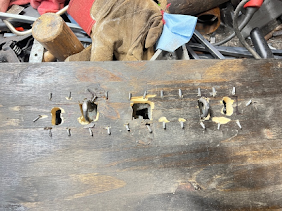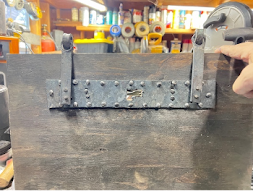Norse Era Slide Lock and Hinges
This is a project I have been wanting to take on for a very long time. So when my Laurel suggested I make a Viking Age lock as a project it occurred to me, why not go all out. So for this project I created an amalgam of a pressure slide lock system (I will explain firther down), replicas of the Mastermyr Box hinges and what we believe the key would have looked like as there is no physical example in the box, just conjecture, "The keyhole, now corroded, had on vertical and on horizontal slot set at right angles, It's form indicates a simple thin hooked key of a completely different type from the keys with toothed bits which are included in the find"1 The box is just a box, a man must know his limitations.
To start this project, I spent countless hours combing over drawing and pictures of extent slide locks of which there aer precious few; and what we do have are mostly bits and pieces which conjecture can piece back together.
In the case of the Mastermyr Box of which I am mostly copying, you can see in Images 1, 2 and 3 the front plate is missing bits and pieces, but the overall design is intact enough to make a fair guess at is was supposed to look like; amd based on the keyhole it must have been the slide lock design. Unfortunately, we have no photos of the inside of the box, just a very un-detailed sketch (image #2), What's most interesting is that the key for the slide lock which is on the box is nowhere to be found.
According to Göta Berg "The locks on the chest are relatively well preserved and therefore contributes to a better understanding of the construction of this type of lock. Our knowledge hitherto has been based on similiar examples from the Birka and Vendel, but these are in a very poor state". The Mastermyr find and the Birka find mirrored each other in time frame. Birka being dated at 750AD and the Mastermyr find 795 - 1066. What is interesting is these types of slide locks would have been used up until the Middle Ages when tumbler locks were invented.
We have two other examples of slide locks in the box.(image #2). These are reverse key which would slide through a horizontal hole in the box and then pull back back to where the teeth of the key would fit into matching holes on the slide and then the slide would be pulled back against the spring allowing he slide freedom of movement. Images #4. #5 and #6 (this is a reproduction of this type of lock)
Once I decided which lock to make I started with the front plate. The Mastermyr box is quite big as you can tell from the picture and the sheer number of tools and implements which were found inside.
#7

I chose to scale down to half scale for the sake of time and sanity. I used a piece of mild steel , 1/8" thick by 2" wide. This closely reflects what was used on the box. By 790 the Viking double bellows forges could reach temperatures as high as 1600-1800 degrees, which created a mild steel from teh introduction of carbon to the Bog iron.
(courtesy of Lars Levin - Forges and Bellows for the VIking Blacksmith) (3)
#8

I marked out all the punch and chisel points then cold chiseled guidelines which will be visible once the steel hits the fire. (images #9 - #11)
The face plate contains 22 nails holes which I hand punched using a square punch i made myself for just such usage. (images #12-#15)
#15

Once I finished the Nail holes, I move to the holes for the supporting rings that will hold the slide in place. and then hot cut the key holes and the slots for the hinge loops. (images #16 - #19)
#16

#17

#18

#19

Once that was done, I made the Mastermyr hinges with the latch loops (image #20-#22). I mounted the the plate onto a scrap piece of wood to enable a correct depth for the loops so the will lock into the slide rod. (image #23)
#20

#21

#22

#23

The last piece of the front plate puzzl;e was the interior lock rings which hold the rod snugly in place so it can slide smoothly (image #24)
#24

Once I mad the locking rings and riveted them to the ends of the front plate, I cut our teh facia board and cut in the holes. Everything lined up as you can see in image #24, but in my haste to secure the lock plate, i forgot to drill pilot holes in the wood and cracked it with the nails. (image #25) sending me back to cut out another facia board.
#25

The next part was the most difficult and time consuming. Making the slide rof. This needed to several things at once. The process required heating and bending and refitting and then heating and re-bending it until:
1) The hook on the far end catches the left latch loop (images #26 and #27
2) The center, where I flattened the round bar to accept the square key, is in a place that will allow it to slide closed (image #28)
3) The right end to slide through the latch on the right side. It took several little adjustments with the and without the latches in the holes. (image #29)
The last part of slide system is a pressure plate that rides above the rod and keeps it tight and in place. I forged that out of mild steel and hand made the rivets to hold it in place (Image #39) Showing here the same Mastermyr diagram of the lock (image #31)
#30

#31

Once the slide was in place and everything worked all that was left to do was make the back hinges, the key, and treat all the metal work with beeswax to preserve it.
Once the box was constructed all the little quirks and eyeball measurements are brought to light. The two latch hinges were not quite the same length so it was necessary to recess the shorter one slightly into the box lid to make it fit correctly. This is very much how something would have been built in period when everything is a one off, and you make things to fit.
One thing you may notice is that all the nails are turned down instead of being clipped . The Norse builders all did this a practice to ensure whatever was being nailed down stayed down. They applied this practice to boat building as well. In the Mastermy booklet it is noted "Only eight if the original twenty remain. The nails are turned over on the inside of the wooden panel"(5)
***THE BOX IS JUST A VEHICLE FOR THE METAL WORK - IT'S NOT PART OF THE PROJECT ****
#32

#33

#34

#35

#36

*** THE KEYHOLE IS FAIRLY RECESSED SO SHINING A LIGHT ON THE SUBJECT WILL MAKE IT EASIER TO FIND***
To sum up this project I can say that to start, this kind of precise metal work is way out of my confort zone which is exactly what Master Estgar wanted me to do on this project. I spent more time thinking about and looking at examples of Norse slide locks (what few images there were) then I do when making something that is already ingrained in my skill set.
I did several thumbnail drawings just to figure out how this thing should go together without one full example to look at The specific historical period and some educated guesses led me to the path of creating a version of the Mastermyr box which absolutely existed, asthe pieces of said locks were in the box. I could have done a replica of the box itself, but I wanted to make a working version of the this type of lock, so it was important for me to pull together period aspects of different known locks. Except for using a propane forge, all the materials, tools and methods were done in a period fashion.
Historians believe the box might have been used for something else before it began to deteriorate and become relegated to a toolbox.
I truly enjoyed being challenge on this project and while at times pieces of this box really wanted to take flight across the shop, I remained calm, took a step out of the shop and returned wih vigor to congquer the steel and force it to succumb to my will. The result being what I believe to be a fair representation of a working version of the Mastermyr Box.
- 1 The Mastermyr Find - a Viking Age Tool Chest from Gotland - by Greta Arwidson and Gösta Berg - Skip Jack Press 1999 PAge 8
- 2 Images #6 Viking lock examples - Lodin's Locks - http://www.fjelborg.org/lodinsvikinglocks.htm
- 3 Image #11 Lars Levin Forge and Bellows for the Viking Blacksmith http://levincraftsmanship.wordpress.com/2017/06/11/viking-forge-bellow/
- 4 Images #31 Mastermyr pages 8, Figure 2
- 5 Mastermy page 7












 .#10
.#10

 #13
#13
























